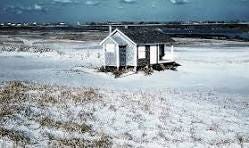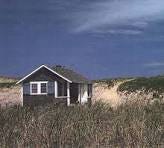Notes From an Environmentalist; Plum Island Beach Walk still on and some reading to ride out the storm.
The Outermost House
Every ten years or so I reread the Outermost House, perhaps the most lyrical piece of nature writing ever written.
This year I recommended it to the Trustees of Reservations Coastal Volunteers book club. I felt a little guilty about recommending a book about someone spending a winter alone on a beach, to people caught up in all the warm, social, holiday cheer of the season.
But as the author Henry Beston points out he never felt lonely. He wrote every evening after spending the day observing the sights, sounds and odors of the ocean, beach and marsh.
His book reads like a daily journal casually dashed off on his kitchen table every night, but his wife revealed that he often spent all day trying to get a single sentence just right. It shows. It is almost impossible to dip into the book and not find an evocative description of a fish, flower or bird to be savored, remembered and quoted.
His wife pointed out he was also a procrastinator. After finishing his manuscript he proposed to his future wife and she answered, “No book no marriage”. Now that is the kind of muse writers really need.
I usually don’t talk about such things but my family has a personal connection to both the Fo’castle and the Cape Cod National Seashore. My uncle had a hunting camp close to the Fo’castle and it helped convince my parents to move to the Cape after World War II.
My father had been in the 10th Mountain ski troops. Like so many of his colleagues the years training in the mountains changed his life and he quit his Boston based architectural practice to build his own camp and run a fishing boat out of Cape Cod’s Rock harbor.
It was during this time that he realized that the fisheries regulations weren’t any good and that nobody paid any attention to them anyway. So he started writing letters to the editor of local papers that caught the eye of then Governor Christian Herter. Eventually my father invited the governor to come down fishing and see for himself.
The next day Herter called back to ask my father if he would be serve as head of the state’s Division of Marine Fisheries. My father balked but said he would as long as he could go back to fishing the next summer.
Part of his job was to give talks to hunting, fishing and environmental groups so he also asked Herter if he could start talking about having Cape Cod become a national park.
The governor said he could, but that if the idea gained traction he, Herter, would take the credit. It was the start of a hard slog; most Cape Cod businessmen were adamantly opposed to the idea.
Several years later Laurence Rockefeller asked my father to direct a commission to make recommendations about the future of the National Park Service. One of recommendations the commission came up with was to create a new category of national park called a national seashore that would be established differently than a traditional national park.
Instead of having the federal government swoop in and take up all the land by eminent domain, the department of interior would be able to negotiate long term leases for family owned homes and camps. One of those camps was Henry Beston’s Fo’castle, “The Outermost House”.
The Fo’castle was declared a national literary monument and moved several times to avoid being washed away. As the nature writer Bob Finch points out in the introduction to the Outermost house, the Fo’castle was the only moving literary monument in America.
But the Fo’castle finally succumbed to the Blizzard of ’78. The following year I wrote my first book about a year in the life of Cape Cod’s Pleasant Bay in homage to The Outermost House.




